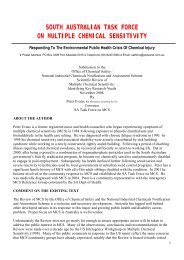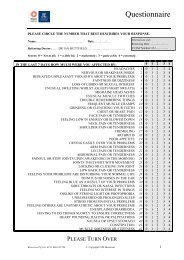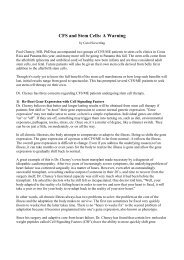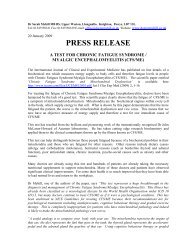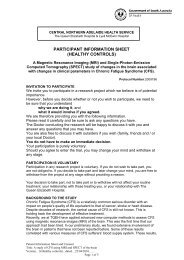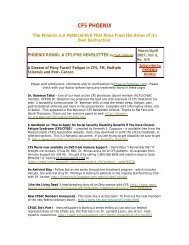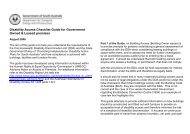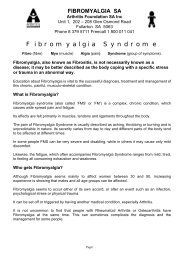ORIGINAL ARTICLEReumatismo, 2008; 60: Supplemento 1: 50-58Fibromyalgia syndrome:the pharmacological treatment optionsIl trattamento farmacologico della sindrome fibromialgicaP. Sarzi-Puttini 1 , R. Torta 2 , F. Marinangeli 3 , G. Biasi 4 , M. Spath 5 , D. Buskila 6 , R.H. Gracely 7 ,M.A. Giamberardino 8 , L. Bazzichi 9 , M. Cazzola 10 , M. Di Franco 11 , S. Stisi 12 , F. Salaffi 13 , R. Casale 14 ,G. Leardini 15 , R. Gorla 16 , A. Marsico 17 , R. Carignola 18 , L. Altomonte 19 , F. Ceccherelli 20 , G. Cassisi 21 ,G. Arioli 22 , A. Alciati 23 , F. Atzeni 1 (Italian Fibromyalgia Network)1Rheumatology Unit, L. Sacco University Hospital, Milan, Italy; 2 Department of Neuroscience, University of Turin, A.S.O. San GiovanniBattista of Turin, Turin, Italy; 3 Department of Anesthesiology and Pain Medicine, L'Aquila University, L’Aquila, Italy; 4 Unit ofRheumatology, University of Siena, Siena, Italy; 5 Friedrich-Baur-Institute, University of Munich, Munich, Germany; 6 Department ofMedicine H, Soroka Medical Center and Faculty of Health Sciences, Ben Gurion University, Beer Sheva, Israel; 7 Department of Medicine,University of Michigan Health System, Ann Arbor, Michigan, USA; 8 Ce.S.I. “G. D’Annunzio” Foundation, Department of Medicine andScience of Aging, “G. D’Annunzio”, University of Chieti , Italy; 9 Department of Internal Medicine, Division of Rheumatology, S. ChiaraHospital, University of Pisa, Italy; 10 Unit of Rehabilitative Medicine “Hospital of Circolo”, Saronno (VA), Italy; 11 Chair of Rheumatology,University la Sapienza Rome, Rome, Italy; 12 Rheumatology Unit, “G.Rummo” Hospital, Benevento, Italy; 13 Department of Rheumatology,Polytechnic University of the Marche Region, Ancona, Italy; 14 Department of Clinical Neurophysiology and Pain Rehabilitation Unit,Foundation Salvatore Maugeri, IRCCS, Scientific Institute of Montescano, Montescano (PV), Italy; 15 Rheumatology Unit, SS Giovanni ePaolo Hospital , Venice, Italy; 16 Rheumatology and Clinical Immunology, Spedali Civili and University of Brescia, Italy; 17 RheumatologyUnit, Hospital of Taranto, Taranto, Italy; 18 Department of Neuroscience, University of Turin, A.S.O.San Giovanni Battista of Turin, Turin, Italy; 19 UOC of Rheumatology Hospital S. Eugenio, Rome, Italy;20IOV (Veneto Cancer Institute), IRCCS, Department of Pharmacology and Anesthesiology, University of Padua, Italy; 21 RheumatologyBranch, Specialist Outpatients’ Department, Belluno, Italy; 22 Division of Rehabilitative Medicine and Rheumatology, General Hospital ofPieve di Coriano (Mantua), Italy; 23 Department of Psychiatry, L. Sacco University Hospital, Milan, ItalyCompeting interests: none declaredRIASSUNTOIl trattamento farmacologico della sindrome fibromialgica (FM) si è gradualmente arricchito di nuove molecole; tuttavia,nessun farmaco da solo è in grado di controllare completamente la costellazione dei sintomi che caratterizzanotale sindrome. Attualmente non è possibile trarre conclusioni definitive sul migliore approccio farmacologico pertrattare la FM, poiché i risultati degli studi clinici controllati presentano limitazioni metodologiche e vi è una consistenteeterogeneità nelle strategie terapeutiche, che rendono gli studi di difficile confronto. Una varietà di trattamentifarmacologici, che comprendono antidepressivi, farmaci antiinfiammatori non steroidei (FANS), oppioidi, sedativi,rilassanti muscolari e anti-epilettici vengono utilizzati per trattare la FM con risultati contrastanti. In questa review,si parlerà principalmente dei farmaci che hanno mostrato i risultati clinici più significativi. La natura della FM suggerisceche un approccio terapeutico a più livelli, sia farmacologico che non farmacologico, sembra costituire attualmentela decisione terapeutica più appropriata.Reumatismo, 2008; 60: Supplemento 1: 50-58INTRODUCTIONFibromyalgia (FM), also known as fibromyalgiasyndrome (FMS), is a frequently observed systemicdisorder characterized by widespread musculoskeletalpain (1, 2). Its prevalence in the generalCorresponding author:Piercarlo Sarzi-Puttini, MDDirector of Rheumatology UnitL. Sacco University Hospital, Milan, ItalyE-mail: sarzi@tiscali.itpopulation is 1-3%, and it is more common amongfemales than males. The American College ofRheumatology (ACR) classification criteria definesit as widespread pain with patients endorsing at least11 of 18 tender points as painful (3). Although itsdefining feature is chronic, widespread pain, FM patientsmay also have a number of other symptomsincluding sleep disturbance, fatigue, irritable bowelsyndrome, headache and mood disorders (1).Current evidence advocates a multifaceted programemphasizing patient education, medications for im-
Fibromyalgia syndrome: the pharmacological treatment options 51proving symptoms, and aggressive use of exerciseand cognitive-behavioural approaches to retain orrestore function (4-6). Physicians and patientsshould be educated about current theories regardingthe underlying pathophysiologic mechanismsof FM, and then set realistic goals for all modalitiesof treatment.However, it is not possible to draw definite conclusionsconcerning the best approach to managingFM because results of randomized clinical trialspresent methodological limitations, and therapeuticprograms are consistently heterogeneous, whichrenders them difficult to compare (7,8). However,a variety of pharmacological treatments, includinganalgesics, antidepressants, antiepileptics andmany other drugs have been used to treat symptomsof FM with mixed results (8). In this review, wewill discuss those drugs that have produced themost significant clinical results in treating FM patients.AnalgesicsThe use of steroids and nonsteroidal anti-inflammatorydrugs (NSAIDs) in FM has had disappointingoutcomes (1, 8). NSAIDs, which are commonlyused for arthritic conditions, may be less effectivefor FM because pain associated with FM isnot caused by muscle or joint inflammation. Thereis no scientific evidence that NSAIDs are effectivewhen used alone in FM patients, although they maybe useful adjuncts for analgesia when combinedwith tricyclic medications (1); the combination ofNSAIDs with benzodiazepines, however, gave inconsistentresults (1, 7-9).The central nervous system (CNS) mechanisms forthe disorder, specifically, central sensitization, centraldisinhibition and a dysfunctional hypothalamic-pituitary-adrenalaxis, could justify the relativelyreduced efficacy of NSAIDs and opioids, thelatter being more effective for “peripheral” pain(7). However, NSAIDs can be helpful in reducingpain that flares with excessive physical activity,tendinitis or bursitis; but they should be used onlyas needed to avoid side effects. COX 2inhibitorshave much fewer side effects, but have less efficacyin pain.Acetaminophen acts differently for FM patients; ithas a degree of strength for FM and is safe for useover long periods (9). Wolfe et al. surveyedrheumatic disease patients about their preferencesfor NSAIDs versus acetaminophen in terms of efficacyand side effects (10). There was a considerableand statistically significant preference forNSAIDs among patients; but the authors stress thatif safety and costs are issues, then the recommendationof the American College of Rheumatologythat acetaminophen be the first choice, primarilyfor mild pain, seems appropriate given the long durationof safe use (11).The use of NSAIDs or acetaminophen, with orwithout opioids, is always justified when patientswho already suffer from FM have other peripheralsources of pain (osteoarthritis, inflammatory arthritis,degenerative disk disease) (11).Opioids are meant to improve function in FM patientswho are impaired by pain, even though thereis an open debate about their usefulness and safetyas a “specific” medication for fibromyalgia patients(12-14).Few clinical trials exist that address the use of opioidsto treat persistent pain in FM patients, butthose trials show that these drugs are helpful for relievingFM pain; moreover, opioids can help to reducesleep disturbances, anxiety and depressionand to increase mobility and enjoyment of life (13,15).Potential side effects tend to decline over time, andaddiction has been disproven by the scientific literature.Opioids that are available on the Italian market includecodeine, tramadol, oxycodone, hydromorphon,morphine, buprenorphine and fentanyl.Furlan et al. (15) conducted a meta-analysis of 41randomized trials (6<strong>01</strong>9 patients, 7% affected byFM) to evaluate the efficacy of opioids ranging induration from 1-16 weeks. They found that opioidswere more effective than placebo for both painand functional outcomes; and strong opioids weresignificantly superior to naproxen and nortriptyline,but only for pain relief. Despite the relativebrevity of the trials, more than 1/3 of the participantsabandoned treatment (15).Tramadol, in particular, was beneficial for FM patients(8, 9, 12-14). It is an atypical pain relieverthat differs from other narcotics in its action on thecentral nervous system, specifically, on reuptakeof serotonin and norepinephrine. Its most commonside effects are drowsiness, dizziness, constipationand nausea, and it should not be given in combinationwith tricyclic antidepressants.Tramadol, used alone or in combination with acetaminophen,is commonly prescribed for relief offibromyalgia pain (16-18) in a dose of 200-300mg/d. A small double-blind, placebo-controlled trialinitially suggested that tramadol was effectiveand well-tolerated in patients with FM (16).
- Page 2 and 3: 2 P. Sarzi-Puttini et al.The meetin
- Page 4 and 5: 4 M. Cazzola et al.(2). In the earl
- Page 6 and 7: 6 M. Cazzola et al.enough to meet F
- Page 8 and 9: 8 M. Cazzola et al.Table I - Charac
- Page 10 and 11: 10 M. Cazzola et al.Table IV - Cond
- Page 12 and 13: 12 M. Cazzola et al.teria, three su
- Page 14 and 15: 14 M. Cazzola et al.tients with a n
- Page 16 and 17: 16 G. Cassisi et al.The cardinal fe
- Page 18 and 19: 18 G. Cassisi et al.StiffnessIn FM
- Page 20 and 21: 20 G. Cassisi et al.Autonomic and n
- Page 22 and 23: 22 G. Cassisi et al.Associated symp
- Page 24 and 25: 24 G. Cassisi et al.46. Coleman RM,
- Page 26 and 27: 26 S. Stisi et al.sensitization,”
- Page 28 and 29: 28 S. Stisi et al.Sum oflife-events
- Page 30 and 31: 30 S. Stisi et al.trols, they prese
- Page 32 and 33: 32 S. Stisi et al.stress, obtained,
- Page 34 and 35: 34 S. Stisi et al.50. Harris RE, Cl
- Page 36 and 37: ORIGINAL ARTICLEReumatismo, 2008; 6
- Page 38 and 39: 38 F. Atzeni et al.lalanine (17), a
- Page 40 and 41: 40 F. Atzeni et al.clearer and it m
- Page 42 and 43: 42 F. Atzeni et al.healthy control
- Page 44 and 45: 44 F. Atzeni et al.and/or verbal (e
- Page 46 and 47: 46 F. Atzeni et al.for study purpos
- Page 48 and 49: 48 F. Atzeni et al.mimics of fibrom
- Page 52 and 53: 52 P. Sarzi-Puttini et al.A larger
- Page 54 and 55: 54 P. Sarzi-Puttini et al.from 1966
- Page 56 and 57: 56 P. Sarzi-Puttini et al.rational,
- Page 58 and 59: 58 P. Sarzi-Puttini et al.49. Toffe
- Page 60 and 61: 60 R. Casale et al.cal exercise and
- Page 62 and 63: 62 R. Casale et al.definition of
- Page 64 and 65: 64 R. Casale et al.are more or less
- Page 66 and 67: 66 R. Casale et al.trol associated
- Page 68 and 69: 68 R. Casale et al.32. Lewit K. The
- Page 70 and 71: ORIGINAL ARTICLEReumatismo, 2008; 6
- Page 72 and 73: 72 L. Altomonte et al.In a clinical
- Page 74 and 75: 74 L. Altomonte et al.Table II - We
- Page 76 and 77: 76 L. Altomonte et al.treatments de



